.png)
.png)
Managing your Outlook inbox can feel overwhelming with the constant influx of client requests, team updates, and urgent messages. However, Outlook remains a vital tool for professional communication, with an estimated 40% share of the email market, especially in larger organizations.
Despite the volume of emails, staying organized is crucial to avoid missed opportunities and unnecessary stress. An efficient system allows you to prioritize important tasks, respond faster, and ultimately boost productivity.
In this guide, we'll cover actionable strategies for streamlining your Outlook inbox, ensuring you can manage it efficiently while reducing overwhelm. Let's get started!
Microsoft Outlook Email Management
Managing emails effectively in Outlook requires more than just checking inbox messages. To regain control and boost productivity, it's crucial to set up your Outlook in a way that reduces clutter and streamlines your workflow. The challenge of dealing with a high volume of emails is real—over 306 billion emails are sent globally each day, with many of them finding their way into your Outlook inbox.
Without the right tools and structure, the constant influx of messages can easily overwhelm you. Thankfully, Outlook offers several features that, when set up strategically, can help you maintain an organized inbox, keep important messages front and center, and save valuable time.
Common Challenges in Managing Emails in Microsoft Outlook
Managing emails in Outlook can become overwhelming due to several factors. Here are the key challenges many professionals face:
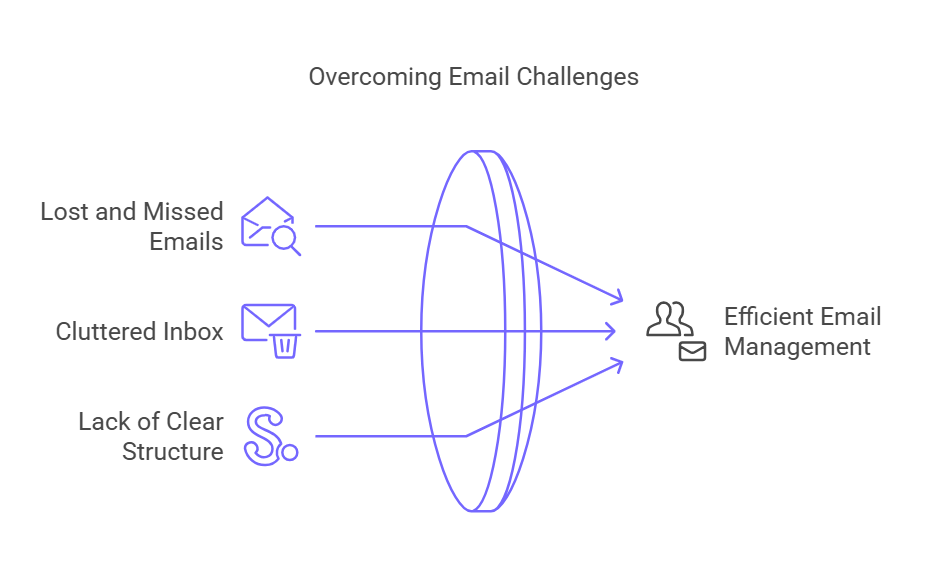
- Lost and Missed Emails: According to data, about 60% of professionals report wasting time searching for lost or misplaced emails. Important messages may get buried without a systematic way to manage your inbox.
- Cluttered Inbox: Studies show that people spend an average of 13 hours per week on email management, much of which is spent dealing with cluttered inboxes. Irrelevant emails take up space, making it hard to find important ones.
- Lack of Clear Structure: Without the right organization, emails quickly become unmanageable. Important tasks, deadlines, and communications get mixed in with less important messages, causing unnecessary stress and missed opportunities.
By acknowledging these challenges and setting up your Outlook with the right strategies, you can tackle these issues head-on and regain control over your email workflow.
How to Organize Your Outlook Inbox for Maximum Efficiency
A cluttered inbox can make finding important messages difficult, staying on top of urgent tasks, and maintaining productivity. By implementing structured email management strategies, you can streamline your workflow, reduce distractions, and ensure that critical communications never get lost. Below are key techniques to help you organize your Outlook inbox effectively.

Prioritize Important Emails First
Sorting emails by priority ensures that urgent messages get addressed first while less critical ones don’t derail your workflow. However, manually sifting through hundreds of emails can be time-consuming.
Use MailMaestro’s Priority Inbox for Smarter Email Triage
Instead of manually identifying high-priority emails, MailMaestro’s Priority Inbox feature scans your inbox based on customized settings and presents your most important messages in a structured list.
Here’s how it works:
- Open an email in Outlook and launch the MailMaestro add-in.
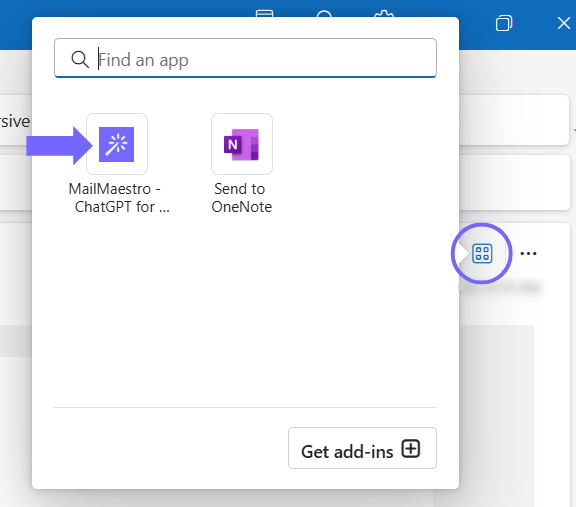
- Click the “Prio Inbox” button at the top.

- Connect your email account if prompted.
- Select filtering settings and click “Find most important emails.”
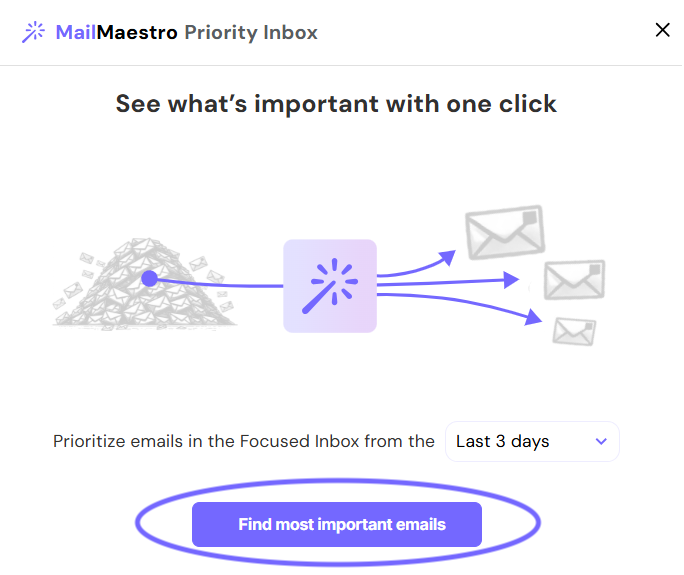
- MailMaestro will analyze your inbox and display prioritized emails with the sender, subject, and a brief summary.
Categorize and Organize Emails for Quick Access
Prioritization helps you focus on the right emails, but proper categorization ensures you store and retrieve them easily. Instead of letting emails pile up randomly, structuring them with folders and color-coded categories makes it simple to track and manage conversations.
Use Folders to Segment Emails by Topic
Folders allow you to organize emails based on projects, clients, or urgency, reducing clutter and improving navigation. Here’s how to create a folder in Outlook:
- Right-click on an email, then select Move.
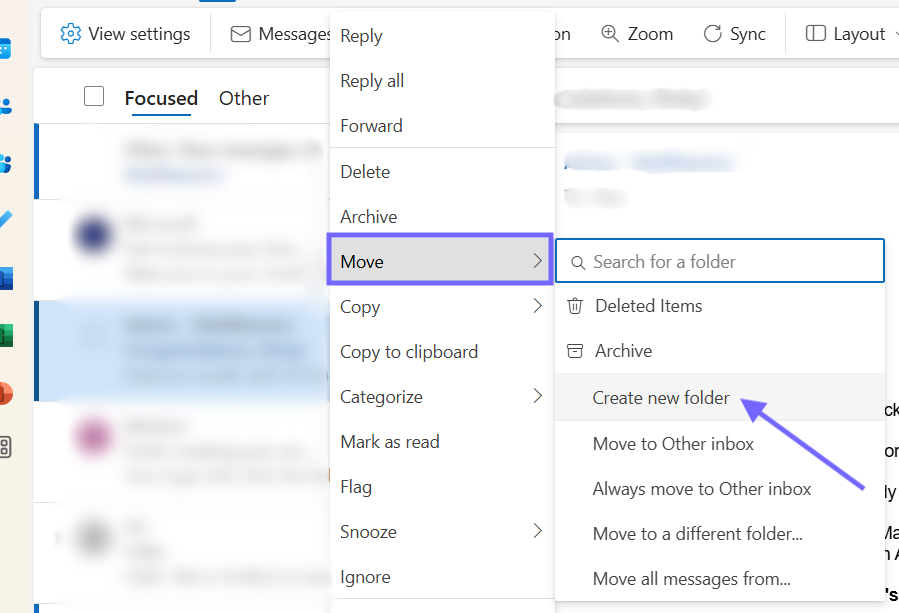
- Select Create new folder and name it based on its purpose (e.g., “Client A,” “Invoices,” or “Meeting Notes”).
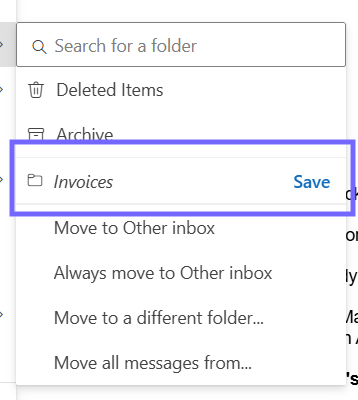
- Repeat the steps to organize all your emails into appropriate folders.
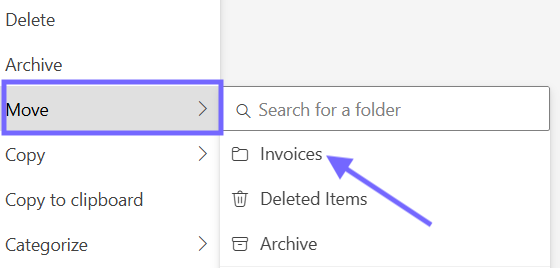
A structured folder system prevents important emails from getting lost and saves time when retrieving messages.
Use Categories for Instant Email Recognition
While folders move emails to different locations, categories allow you to label and color-code messages without relocating them. This is useful for visually identifying high-priority emails at a glance. To use categories:
- Click on the Inbox tab and select Categories from the ribbon.
- Assign a color and label that represents the type of email (e.g., “Urgent,” “Pending Review,” or “Follow-Up”).
- Apply the category by selecting an email and clicking the Categories button.
Categories provide a quick visual cue, helping you spot urgent or relevant emails instantly without searching through your inbox.
Automate Sorting to Reduce Manual Work
Once you have folders and categories set up, automation can handle repetitive sorting for you. Outlook’s Rules feature allows you to automatically move emails into specific folders based on the sender, keywords, or subject line.
How to create categories for Microsoft Outlook email sorting:
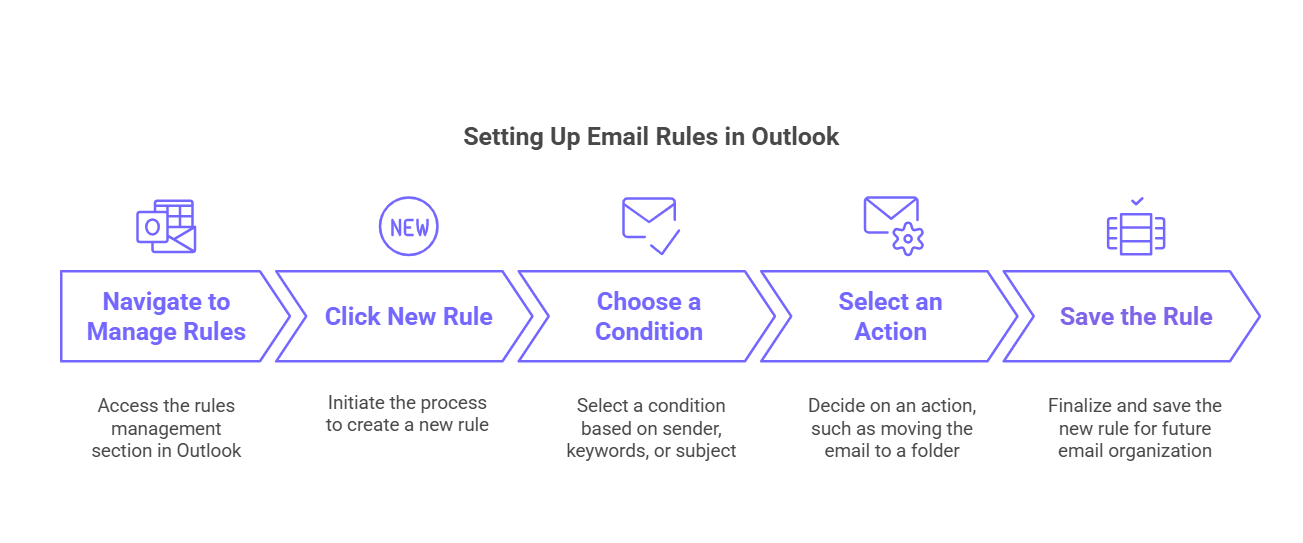
- Navigate to File > Manage Rules & Alerts in Outlook.
- Click New Rule and choose a condition (e.g., sender, keywords, or subject).
- Select an action, such as moving the email to a designated Out folder.
- Save the rule, and Outlook will automatically organize matching emails in the future.
For example, you can create rules that send all newsletters to a “Newsletters” folder, keeping your primary inbox free of non-urgent messages.
Use Flags and Reminders to Track Important Emails
Even with prioritization and automation, some emails require follow-up at a later time. Outlook’s Flags feature ensures that critical messages don’t slip through the cracks.
How to Use Flags Effectively
- Flag emails that need follow-up and assign due dates to keep track of deadlines.
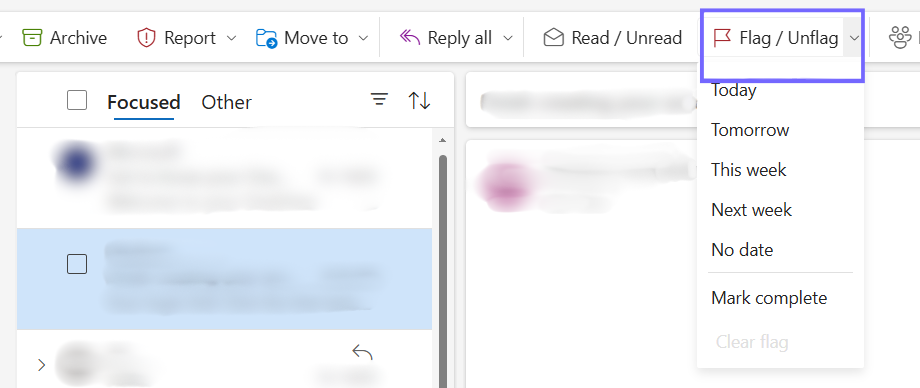
- Use reminders to get notified when it’s time to respond or take action.
- Sort flagged emails into a “To-Do” folder to maintain a clear action list.
For instance, if you receive an important request from your manager, you can flag it with a follow-up reminder to ensure you respond before the deadline.
Best Practices for Maintaining an Organized Outlook Inbox
Organizing your Outlook inbox is just the beginning—it's essential to implement the right practices to ensure you can sustain that organization in the long term. By following these best practices, you'll maintain an efficient inbox, enhance productivity, and prevent feeling overwhelmed by email clutter. Here's how you can consistently manage and streamline your Outlook email inbox:
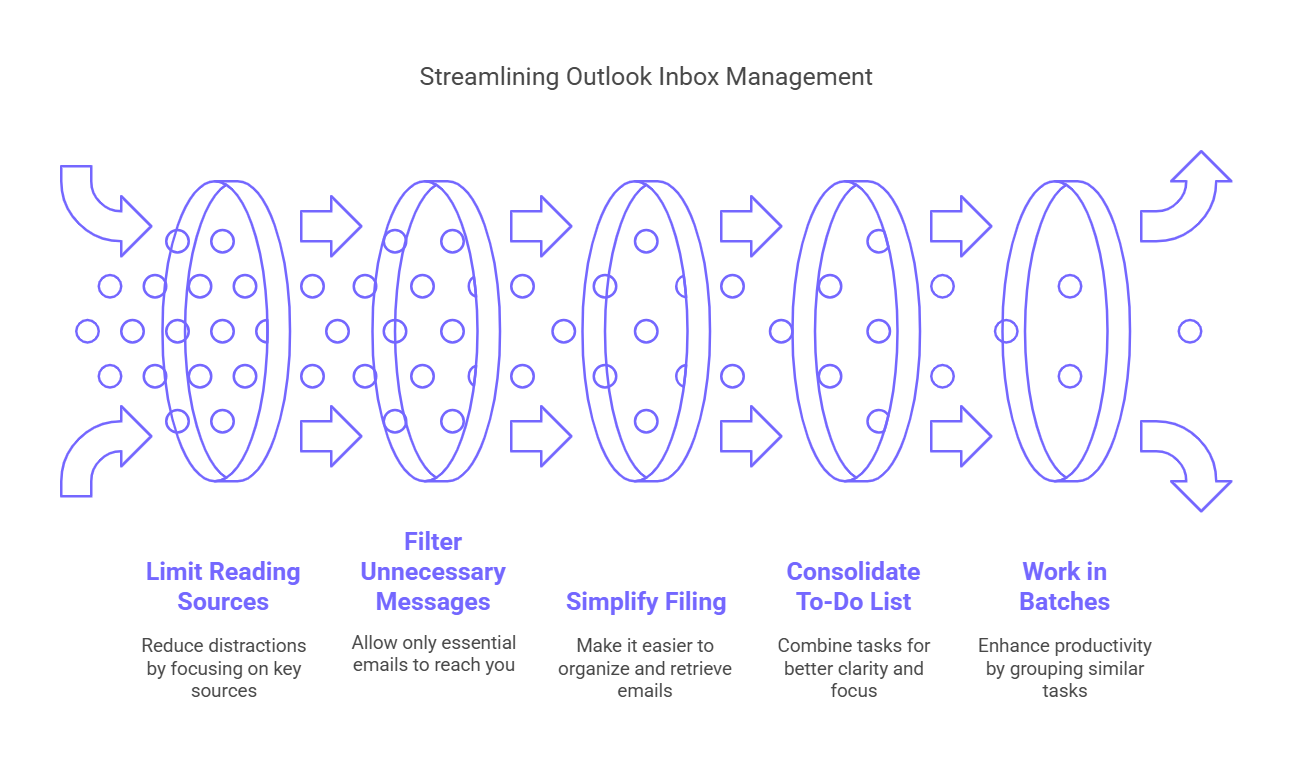
Limit the Number of Places You Read Messages From
Managing your emails across multiple apps or platforms can cause fragmented communication, making it harder to stay organized and respond promptly. Consolidating your email management to one platform keeps everything in one place, helping you stay focused.
How to Implement:
- Use Outlook as your primary platform: Centralize all your email communication within Outlook, whether it’s for work or personal use. This will allow you to process everything in one location, making it easier to prioritize.
- Turn off email notifications on other apps: Disable notifications on any other email apps (e.g., Gmail, Yahoo) to reduce distractions. By only focusing on notifications from Outlook, you can manage your emails more efficiently.
- Consolidate all email accounts into Outlook: Use Outlook’s multi-account feature to add your Gmail, Yahoo, or other email services. This integration lets you read, reply to, and organize all emails without switching apps, improving your workflow.
Let Unnecessary Messages Pass By
A cluttered inbox can be overwhelming and decrease productivity. Automatically filtering low-priority emails lets you focus on what truly matters, without distraction.
Actionable steps:
- Enable focused inbox: Focused Inbox automatically sorts your incoming messages into two tables: Focused (for important emails) and Other (for low-priority emails).
- How to enable: Go to View tab in Outlook, click on Show Focused Inbox, and select Turn on Focused Inbox.

- Fine-tune settings: Customize Focused Inbox by adjusting the settings to control what emails get filtered. This includes prioritizing emails from important contacts or specific subjects.
- Review the other tab periodically but prioritize emails in the Focused tab. Set aside specific times to check the "Other" tab, so you're not constantly distracted by low-priority emails.
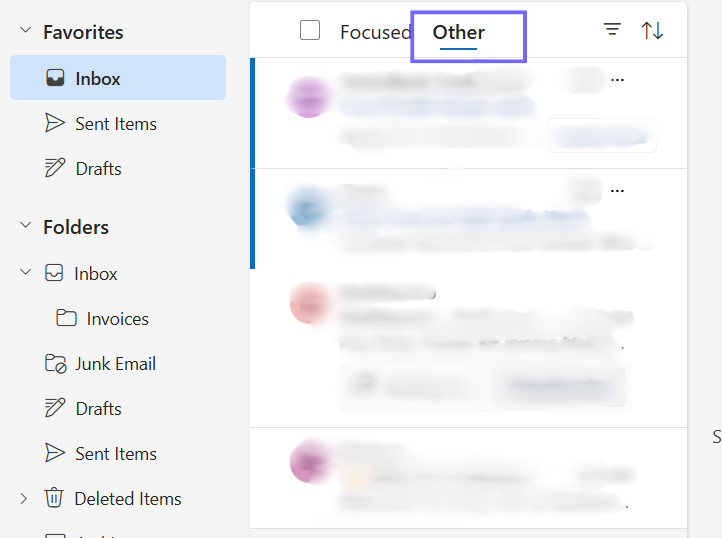
- Mark low-priority emails as 'Ignore': For recurring irrelevant emails, use the "Ignore" feature to automatically delete threads you no longer want to see.
Simplify the Filing Process
Sorting and filing emails manually can take up a lot of time and can be inconsistent. Automating this process through rules and categories helps you stay organized and saves time, especially as your inbox grows.
How to put this into practice:
- Set up rules: Use Outlook’s Rules feature to sort incoming message folders automatically based on criteria like sender, subject, or keywords. For example, emails from a specific sender can be routed directly to a designated Outlook folder.
How to Set Up Rules:
1. Go to View
2. Click on View Settings > Rules.
3. Select Add new rule, then follow the prompts to create a custom rule (e.g., "Move emails from a specific sender to a designated Outlook folder").
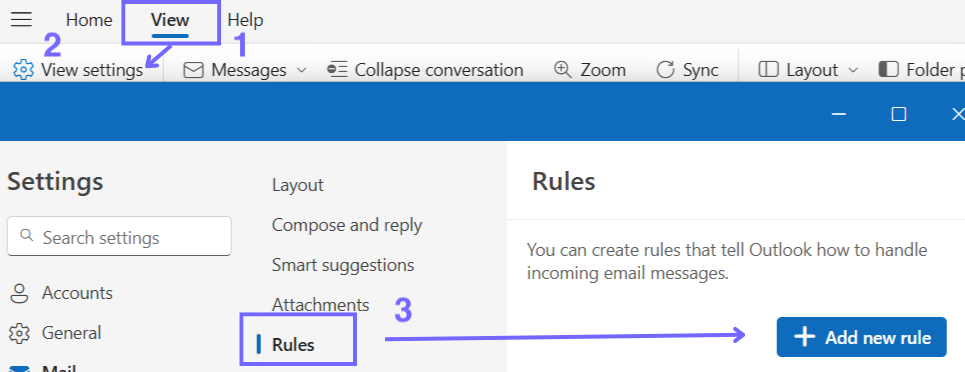
- Create folders and subfolders: Organize your emails into specific folders based on topics, projects, or clients. Subfolders within main folders can help to further categorize and sort emails.
How to create folders: Right-click on the Inbox in Outlook, select New Folder, and name it accordingly.
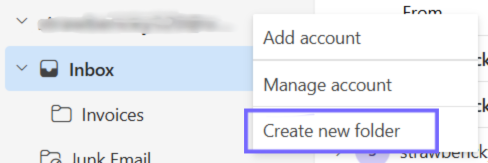
Process Emails Using the Four Ds
The Four Ds method helps you make quick decisions on how to handle each email. This strategy helps reduce your inbox clutter and prevents you from spending too much time on low-priority tasks.
How to put it into practice into your Microsoft Outlook inbox:
- Delete unnecessary messages: If the email is spam, use Outlook's Mark as Junk feature to prevent similar emails from entering your inbox in the future.
- Do tasks that take 2 minutes or less immediately: If an email requires a simple action, such as answering a quick question or confirming a meeting, respond immediately. You can use the Rapid reply feature of MailMaestro to send brief replies.
- Delegate emails that require someone else’s attention: Forward emails that need action from someone else. Include clear instructions to ensure the recipient knows what’s needed.
- Defer emails requiring more time: Move them to a task list or create a Follow-up flag to handle them later. This keeps your inbox free from unfinished tasks.
Consolidate Your To-Do List
Tracking tasks directly from your inbox ensures that nothing falls through the cracks. By turning emails into tasks, you can stay organized and ensure follow-through.
How to consolidate your Microsoft Outlook task list:
- Use the To-Do Bar in Outlook to keep track of tasks and deadlines.
- How to Enable To-Do Bar: Go to the View tab, click on To-Do Bar, and select Tasks. This will display your upcoming tasks alongside your emails for easy access.
- Convert emails into tasks: Drag and drop important emails into the Tasks pane. This automatically turns them into actionable tasks with due dates.
- How to Create Tasks from Emails: Right-click on an email and select Create Task. You can set a due date and add detailed notes.
- Review tasks daily: Schedule a daily review of your task list. Prioritize tasks and check off completed items to maintain a clear and actionable to-do list.
Work in Batches
Email processing is a time-consuming activity, and doing it in batches reduces the mental load of constantly switching between tasks. Working in designated sessions helps you stay focused and productive.
Here's how to work in batches on Microsoft Outlook email:
- Schedule specific times to process emails: Rather than checking emails constantly throughout the day, block out specific times to process them.
- Example: Set aside 30 minutes in the morning, 30 minutes after lunch, and 30 minutes at the end of the workday for email management.
- Avoid distractions during email processing: Turn off non-urgent notifications and resist the temptation to check social media or browse the web during email sessions.
- Set email limits: Limit the number of emails you handle during each session. This helps you focus on what truly matters and prevents unnecessary emails from piling up.
Regularly Review Your Calendar
Staying aligned with your schedule ensures that you don’t miss important appointments or deadlines. Syncing your calendar with your Outlook inbox gives you a complete view of your day’s events directly from your email. MailMaestro’s AI-powered meeting request feature takes this a step further by streamlining the scheduling process, so you can focus on what truly matters while eliminating the stress of back-and-forth emails.
How to Implement:
- Sync your calendar with Outlook: Ensure your Outlook Calendar is linked to your email. This will allow you to see upcoming events directly in your inbox, set reminders for meetings, and keep everything in sync with your schedule.
- Leverage MailMaestro’s meeting scheduling feature: When you receive a meeting request, MailMaestro scans your calendar and shows your availability in real-time. It highlights free (green) and busy (red) slots, helping you quickly pick a time that works for you.

- Respond to meeting invitations with AI: Once you select a time, MailMaestro generates a meeting confirmation email with one click. It provides up to three email variations for you to choose from, ensuring a polished and professional response without extra effort.
- Pin MailMaestro for Instant Access: MailMaestro’s AI assistant can be pinned to your Outlook sidebar, ensuring it’s always easily accessible. Whenever you receive a meeting request, you can respond instantly with the AI’s help—no extra searching or navigating required.
Create Email Templates
Creating email templates can save time and reduce repetitive writing, especially for common responses. Templates allow you to respond quickly without crafting each email from scratch.
What to do:
- Access the template builder: Open the template builder in your email tool or use a tool like MailMaestro to create and manage your templates.
- Prepare your email: Write or paste the email you frequently send, such as meeting confirmations or follow-up messages.
- Identify variables: Identify parts of the email that change (e.g., recipient names, meeting dates) and mark them as variables.
- Choose template type: Tools like MailMaestro offer dynamic templates (like Magic Templates) that adapt to your input, while static templates keep the content fixed.
- Save and use: Save your template for future use and update the variables as needed each time you send the email.
Optimize Outlook View Settings
Customizing your Outlook view ensures you're focused on the right information without distractions, making it easier to navigate your inbox and stay organized.
How to implement:
- Use the To-Do bar: Keep your calendar and task list visible next to your inbox, so you can see upcoming tasks and meetings without switching windows.
How to Enable: Go to View > To-Do Bar, then select Tasks.
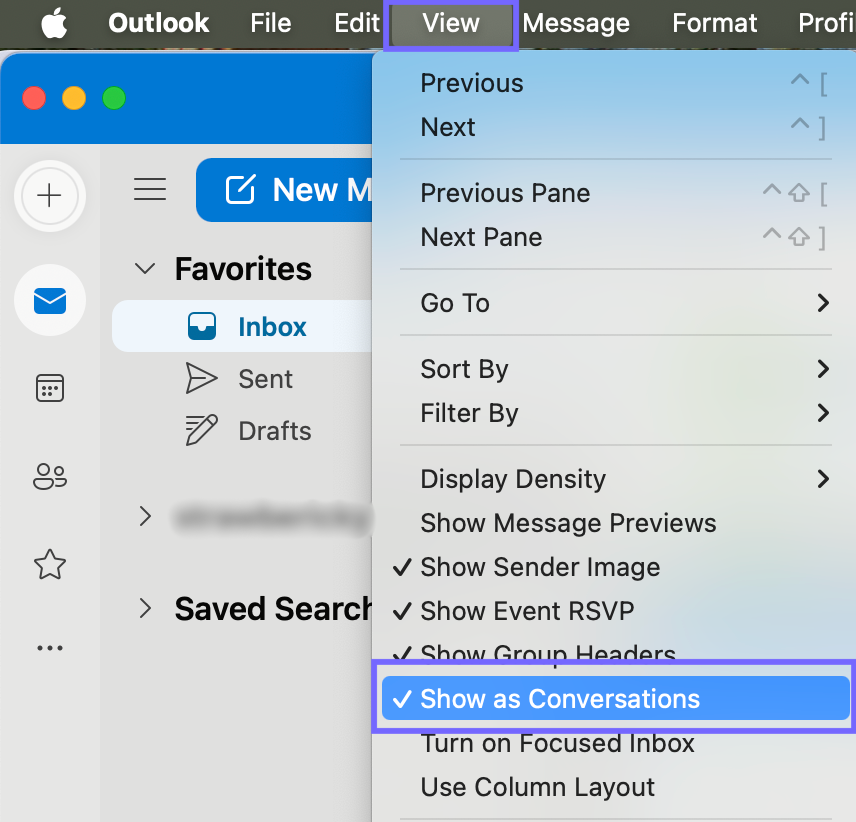
- Show emails as conversations: Group related emails together to reduce clutter and avoid missing any important replies within a thread.
How to Enable: In the View tab, click Show as Conversations, then select All Mailboxes or This Folder.
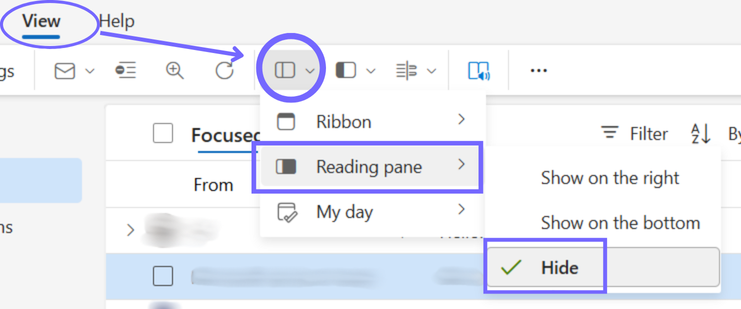
- Disable the Reading Pane: If the Reading Pane distracts you or slows you down, disable it so you can preview emails before opening them fully.
How to Disable: Go to View > Reading Pane, then select Hide.

Conclusion
Managing your email in Outlook doesn’t have to be daunting. By applying these strategies—ranging from using folders, categories, and flags to automating tasks and integrating with Microsoft To-Do—you can drastically improve your email efficiency and reduce stress. These tips not only help you stay organized but also allow you to stay focused on your most important tasks.
Ready to optimize your inbox? Try MailMaestro’s AI-driven email management features now and experience a more organized, efficient Outlook inbox!
FAQs on Maintaining an Organized Outlook Inbox
How often should I check my Outlook inbox?
Limit your email-checking sessions to specific times, such as once in the morning and once at the end of the day. This helps reduce distractions and keeps you focused on other important tasks without being interrupted by new emails.
How can I sort and organize my emails efficiently?
Use Outlook’s rules to automatically sort incoming emails into designated folders based on criteria like sender or subject. This will help reduce clutter in your inbox and make it easier to find important messages when needed.
How can I prioritize important emails in Outlook?
Enable the Focused Inbox feature in Outlook to separate important emails from less critical ones. You can also manually flag emails for follow-up or use tools like MailMaestro’s Priority Inbox to help prioritize high-priority messages.
What are the best ways to declutter my Outlook inbox?
Regularly delete unnecessary emails, unsubscribe from unwanted mailing lists, and archive old emails that are still important but don’t require immediate action. Set up rules to automatically filter and sort emails for better organization.
How can I handle a large volume of emails in Outlook?
For high volumes of emails, use Outlook’s Quick Steps to automate common tasks, like moving emails to specific folders or marking them as read. Regularly clean up your inbox by deleting outdated or irrelevant messages and organizing what remains.
Lorem ipsum dolor sit amet, consectetur adipiscing elit. Suspendisse varius enim in eros elementum tristique. Duis cursus, mi quis viverra ornare, eros dolor interdum nulla, ut commodo diam libero vitae erat. Aenean faucibus nibh et justo cursus id rutrum lorem imperdiet. Nunc ut sem vitae risus tristique posuere.



follow-up on our previous call, ask if he’s ready to start cooperation let him know that our discount ends tomorrow ask him if he had time to calculate roi










